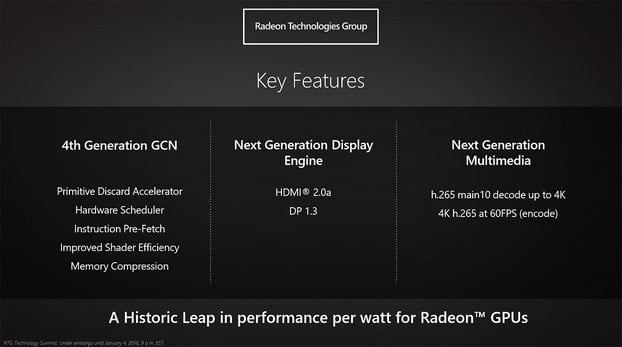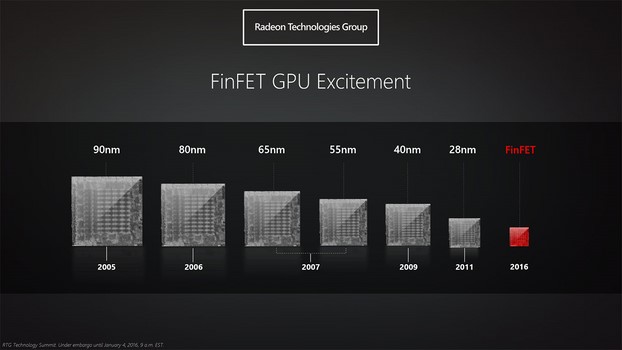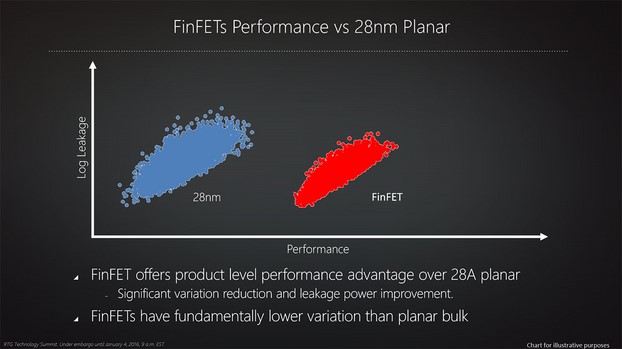AMD RTG Reveals Next-Gen Polaris GPU Architecture Designed For FinFET
AMD RTG Polaris GPU Architecture
A few weeks back, we attended a summit hosted by AMD’s Radeon Technologies Group. A number of new initiatives and technologies were disclosed at the event, including AMD’s plans to support FreeSync over HDMI along with other new display technologies. Also discussed was the company’s GPUOpen initiative, which is meant to give developers of games, heterogeneous computing applications, and HPC applications deeper access to the GPU and GPU resources through new open-source tools.
Today, as we prepare for the craziness of the Consumer Electronics Show, we can reveal the final major disclosure from the summit – details of the AMD Radeon Technologies Group’s next-generation GPU architecture, code-named Polaris.
The Polaris architecture will eventually be the foundation of a new family of Radeon GPUs that span an array of market segments, from thin and light notebooks to high-end discrete graphics cards. According to the Radeon Technologies Group’s Joe Macri, GPUs based on the Polaris architecture represent the largest performance-per-watt improvement in Radeon GPUs to date.
Polaris’ key features include a 4th-generation version of AMD’s GCN (Graphics Core Next) architecture, with a number of improvements and new features. There’s new Primitive Discard Acceleration baked-in, along with an improved hardware scheduler, better instruction prefetch, and increased shader efficiency. There’s an enhanced memory compression technology built-in as well, which improves upon the compression tech introduced with the Tonga GPU.
GPUs based on Polaris with feature a new display engine as well, with HDMI 2.0 and DisplayPort 1.3 support, and a new multimedia engine, with H.265 main10 decode at resolutions up to 4K at 60Hz.
Another key benefit of Polaris is that it is designed for bleeding edge manufacturing processes using FinFET transistors. If you’re unfamiliar with FinFETs, there a type of transistor that essentially wraps the gate around the source and drain, using 3D structures that rise above the planar substrate. The design of FinFET transistors offers twice as much gate control versus a traditional planar gate and allows for more on current and lower off current. The FinFETs are built as uniform structures as well, with similar heights, which improves variation. The end result is that FinFETs offer better performance and density at similar leakage levels versus planar transistors.
GPUs based on the Polaris architecture – and APUs featuring Polaris-based GPU engines -- are designed to be built using both TSMC’s 16nm and Global Foundries 14nm FinFET manufacturing processes.
FinFETs will help drive Radeon GPUs down to lower overall power consumption levels and enable better performance per watt. New GPU designs manufactured using the latest process technologies will also enable next generation Radeon GPUs to be used in new product categories, from ultra small form factor systems and all-in-ones, to thin and light notebooks. Discrete cards with fewer power connectors and lower power requirements at a given performance level will also come as a result.
One of the things the Radeon Technologies Groups would like to do with Polaris is build low-power GPUs for thin and light form factors that offer better than current generation console level performance and fidelity, with state of the art display technologies and multimedia features, like those mentioned in the first slide above.
To that end, we were shown a brand new GPU that was less than two months removed from the fab. The exact features and specifications of the GPU weren’t disclosed, but it was physically very small and in a live demo it consumed minimal amounts of power in comparison to an NVIDIA GeForce GTX 950.
Now, the demo didn’t use a thin and light form factor system or notebook. In fact, the Polaris-based GPU that was shown was installed into a desktop system. And although there will be GPUs based on Polaris at some point in the future that leverage HBM (High Bandwidth Memory) technology, like the Radeon Fury, the chip shown was paired to GDDR5 memory.
Keep in mind, the GPU is still in the early stages of bring up, and we were told many features were not turned on or enabled in software yet. Even so, the system featuring Polaris consumed significantly less power. The power improvements were basically the result of using FinFETs combined with the architectural enhancements inherent to Polaris. Additional improvements should be coming as the GPU gets closer to launch.
The demo systems featured Intel with Core i7-4790 CPUs and 8GB of RAM, and ran a 64-bit edition of Windows 10. While gaming at 1080P with Star Wars Battlefront, the system featuring the Polaris based GPU was pulling only 86 – 88 watts from wall, while an identical system, with a GTX 950 installed pulled over 150 watts. Both systems were running the game with medium settings and achieved 60 frames per second.
The chip used in the demo was manufactured using Global Foundries’ 14nm FinFET process and should be available in mid-2016.
Today, as we prepare for the craziness of the Consumer Electronics Show, we can reveal the final major disclosure from the summit – details of the AMD Radeon Technologies Group’s next-generation GPU architecture, code-named Polaris.
The Polaris architecture will eventually be the foundation of a new family of Radeon GPUs that span an array of market segments, from thin and light notebooks to high-end discrete graphics cards. According to the Radeon Technologies Group’s Joe Macri, GPUs based on the Polaris architecture represent the largest performance-per-watt improvement in Radeon GPUs to date.
Polaris’ key features include a 4th-generation version of AMD’s GCN (Graphics Core Next) architecture, with a number of improvements and new features. There’s new Primitive Discard Acceleration baked-in, along with an improved hardware scheduler, better instruction prefetch, and increased shader efficiency. There’s an enhanced memory compression technology built-in as well, which improves upon the compression tech introduced with the Tonga GPU.
GPUs based on Polaris with feature a new display engine as well, with HDMI 2.0 and DisplayPort 1.3 support, and a new multimedia engine, with H.265 main10 decode at resolutions up to 4K at 60Hz.
Another key benefit of Polaris is that it is designed for bleeding edge manufacturing processes using FinFET transistors. If you’re unfamiliar with FinFETs, there a type of transistor that essentially wraps the gate around the source and drain, using 3D structures that rise above the planar substrate. The design of FinFET transistors offers twice as much gate control versus a traditional planar gate and allows for more on current and lower off current. The FinFETs are built as uniform structures as well, with similar heights, which improves variation. The end result is that FinFETs offer better performance and density at similar leakage levels versus planar transistors.
GPUs based on the Polaris architecture – and APUs featuring Polaris-based GPU engines -- are designed to be built using both TSMC’s 16nm and Global Foundries 14nm FinFET manufacturing processes.
FinFETs will help drive Radeon GPUs down to lower overall power consumption levels and enable better performance per watt. New GPU designs manufactured using the latest process technologies will also enable next generation Radeon GPUs to be used in new product categories, from ultra small form factor systems and all-in-ones, to thin and light notebooks. Discrete cards with fewer power connectors and lower power requirements at a given performance level will also come as a result.
One of the things the Radeon Technologies Groups would like to do with Polaris is build low-power GPUs for thin and light form factors that offer better than current generation console level performance and fidelity, with state of the art display technologies and multimedia features, like those mentioned in the first slide above.
To that end, we were shown a brand new GPU that was less than two months removed from the fab. The exact features and specifications of the GPU weren’t disclosed, but it was physically very small and in a live demo it consumed minimal amounts of power in comparison to an NVIDIA GeForce GTX 950.
Now, the demo didn’t use a thin and light form factor system or notebook. In fact, the Polaris-based GPU that was shown was installed into a desktop system. And although there will be GPUs based on Polaris at some point in the future that leverage HBM (High Bandwidth Memory) technology, like the Radeon Fury, the chip shown was paired to GDDR5 memory.
Keep in mind, the GPU is still in the early stages of bring up, and we were told many features were not turned on or enabled in software yet. Even so, the system featuring Polaris consumed significantly less power. The power improvements were basically the result of using FinFETs combined with the architectural enhancements inherent to Polaris. Additional improvements should be coming as the GPU gets closer to launch.
The demo systems featured Intel with Core i7-4790 CPUs and 8GB of RAM, and ran a 64-bit edition of Windows 10. While gaming at 1080P with Star Wars Battlefront, the system featuring the Polaris based GPU was pulling only 86 – 88 watts from wall, while an identical system, with a GTX 950 installed pulled over 150 watts. Both systems were running the game with medium settings and achieved 60 frames per second.
The chip used in the demo was manufactured using Global Foundries’ 14nm FinFET process and should be available in mid-2016.












